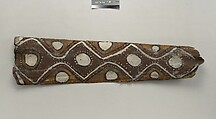Painting from a Ceremonial House Ceiling
Not on view
Throughout New Guinea, men’s ceremonial houses were, and in many places still are, the primary focus for painting and sculpture. Like the cathedrals of medieval Europe, they are generally the largest and most sacred buildings in the village, rising high above the ordinary dwellings that surround them. Typically, entry into the ceremonial house is restricted to initiated men, although in some cases, women and children can enter under certain circumstances for specific events. Ceremonial houses serve as the venue for nearly all important male religious rites – such as initiation rites for young boys - and at other times function as meeting houses or informal gathering places. Their structure and the way they are decorated can take on many different local forms and styles.
The Kwoma are a small group of people living in the hills north of the Sepik River in northeast New Guinea. Among the Kwoma people of the Washkuk Hills ceremonial houses have no walls; instead, they consist of a hug
Due to rights restrictions, this image cannot be enlarged, viewed at full screen, or downloaded.

